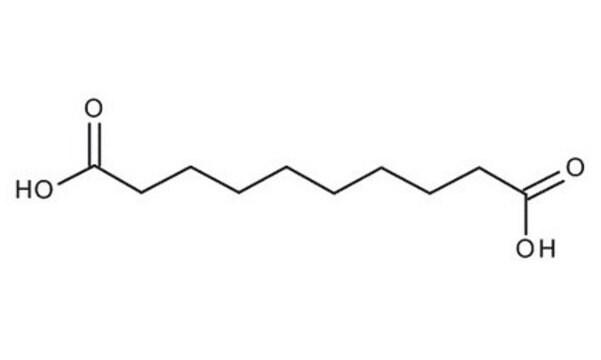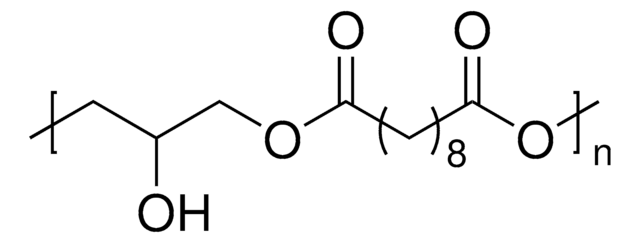추천 제품
vapor pressure
1 mmHg ( 183 °C)
분석
≥95.0% (GC)
bp
294.5 °C/100 mmHg (lit.)
mp
133-137 °C (lit.)
작용기
carboxylic acid
SMILES string
OC(=O)CCCCCCCCC(O)=O
InChI
1S/C10H18O4/c11-9(12)7-5-3-1-2-4-6-8-10(13)14/h1-8H2,(H,11,12)(H,13,14)
InChI key
CXMXRPHRNRROMY-UHFFFAOYSA-N
유사한 제품을 찾으십니까? 방문 제품 비교 안내
Storage Class Code
11 - Combustible Solids
WGK
WGK 1
Flash Point (°F)
Not applicable
Flash Point (°C)
Not applicable
개인 보호 장비
Eyeshields, Gloves, type N95 (US)
이미 열람한 고객
Magdalena Kwiatkowska et al.
Polymers, 12(2) (2020-02-08)
In this work the preparation of polyamide 12 (PA12) based composites reinforced with pristine and surface-modified carbon nanotubes is reported. A qualitative and quantitative evaluation of multi-walled carbon nanotube functionalization with oxygen containing reactive groups achieved by different procedures of
Hyung-seok Park et al.
Acta biomaterialia, 8(8), 2911-2918 (2012-04-24)
High molecular weight biodegradable polyesters were prepared from sebacic acid, ethylene glycol and butylene glycol through a simple non-solvent polycondensation with a low toxicity catalyst. The successful synthesis of the polyesters was confirmed by gel permeation chromatography, (1)H-nuclear magnetic resonance
A Bertuzzi et al.
Biochemical pharmacology, 45(3), 697-702 (1993-02-09)
Sebacic (decanedioic) acid is a dicarboxylic acid proposed recently as an alternative energy substrate in total parenteral nutrition. In this paper, binding of sebacic acid to defatted human plasma albumin, also in the presence of decanoic acid, was studied by
Easy fabrication and morphology control of supramolecular liquid-crystalline polymer microparticles.
Hui Liu et al.
Macromolecular rapid communications, 32(4), 378-383 (2011-03-25)
A novel kind of supramolecular liquid-crystalline polymer (SLCP) microparticles was successfully fabricated with an azopyridyl polymer and sebacic acid by combining a simple self-organized precipitation method with hydrogen bonding interactions. Upon slow evaporation of a mixed solution of a volatile
Christiane L Salgado et al.
Tissue engineering. Part A, 18(1-2), 137-146 (2011-09-10)
Tissue engineering constitutes a promising alternative technology to transplantation medicine by creating viable substitutes for failing tissues or organs. The ability to manipulate and reconstitute tissue function has tremendous clinical implications and will most likely play a key role in
자사의 과학자팀은 생명 과학, 재료 과학, 화학 합성, 크로마토그래피, 분석 및 기타 많은 영역을 포함한 모든 과학 분야에 경험이 있습니다..
고객지원팀으로 연락바랍니다.













